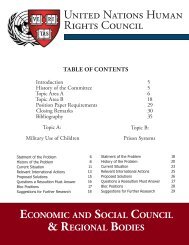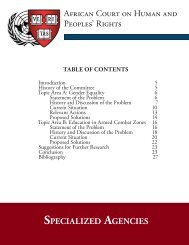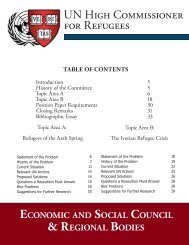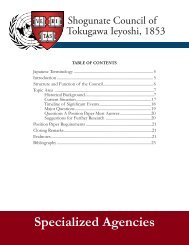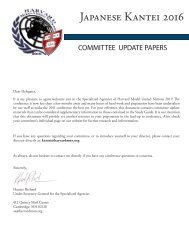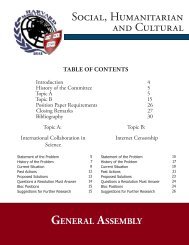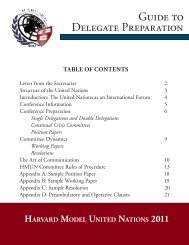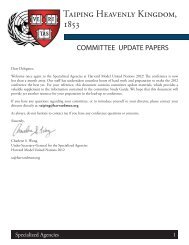World Trade Organization - Harvard Model United Nations
World Trade Organization - Harvard Model United Nations
World Trade Organization - Harvard Model United Nations
Create successful ePaper yourself
Turn your PDF publications into a flip-book with our unique Google optimized e-Paper software.
<strong>World</strong> <strong>Trade</strong> <strong>Organization</strong><br />
products industries. These industries are large consumers<br />
for industrial chemicals. The increased demand for<br />
industrial chemicals coupled with the lack of a strong<br />
environmental regulation system in Vietnam has resulted<br />
in major toxic and water pollution. 50<br />
Impact of NAFTA on the Environment<br />
The North American Free <strong>Trade</strong> Agreement (NAFTA)<br />
opened up significant trade between the US and Mexico.<br />
However, it has also greatly impacted the maize trade as<br />
well as the environment of both countries.<br />
Environmental impact in the US<br />
Corn is one of the <strong>United</strong> States’ largest and most<br />
chemical-intensive crops. Twenty percent of all the<br />
harvested land in the U.S is for corn. Chemical fertilizers<br />
are used on the majority of US corn crops and run-off<br />
is a major source of water pollution around the “corn<br />
belt” in the middle of the country. Most shocking is the<br />
presence of a dead zone within the Gulf of Mexico. An<br />
area the size of a small US state is completely devoid of<br />
all life due to run-off from the Mississippi River, which<br />
empties into the Gulf of Mexico. The environmental<br />
impact of growing corn is not just limited to pollution; it<br />
also depletes valuable natural resources. The majority of<br />
irrigated corn fields reside in Nebraska, Texas, Colorado,<br />
and Oklahoma. These states rely on the Ogallala Aquifer<br />
which is being depleted at unsustainable rates. These<br />
signs of environmental degradation have only been<br />
exacerbated by the opening of the Mexican market to<br />
US corn. Land in the US that would’ve otherwise been<br />
used to grow other crops is now growing corn. The<br />
aggregate effects of increased corn production from<br />
trade liberalization include 100,000 additional tons of<br />
nitrogen, phosphorous, and potassium-based loadings to<br />
US water each year. 51<br />
Environmental impact in Mexico<br />
For Mexico, the negative environmental impact of<br />
corn trade liberalization is the loss of agro-biodiversity.<br />
Mexico has 40 distinct native maize varieties resulting<br />
from both natural selection and artificial selection<br />
by farmers over thousands of years. Approximately<br />
20 percent use only very little modern fertilizers for<br />
chemical inputs. Such agro-biodiversity is important not<br />
only because it is a center of Mexican culture, but also<br />
because Mexico’s diverse varieties of corn are essential for<br />
crop-breeding to meet growing demand for corn varieties<br />
throughout the world. 52<br />
The trade in corn between Mexico and the US impacts<br />
agro-biodiversity in two ways. <strong>Trade</strong> liberalization<br />
in corn brought a flood of corn imports from the US,<br />
cutting prices by nearly 50 percent. This puts pressure<br />
on many of the marginal maize farmers that make up the<br />
20 percent of Mexico’s economically active population<br />
that grow corn. As farmers lose competitiveness, they<br />
will migrate to other areas within Mexico to find better<br />
paying jobs, taking the diverse agricultural knowledge<br />
with them. 53<br />
The second way trade impacts agro-biodiversity is<br />
the contamination of traditional cornfields by genetically<br />
modified (GM) corn crops from the US. Research from<br />
the North American Commission for Environmental<br />
Cooperation (NACEC) has shown that the spread of<br />
GM varieties through Mexico’s corn fields has been more<br />
rapid than previously thought, leading to the fear that<br />
many traditional varieties of maize will not be able to<br />
compete with these new herbicide and Bt tolerant maize<br />
varieties. 54<br />
Current Situation<br />
Leaders of the G20 rich and emerging economies called for intensified<br />
efforts to complete the long-running Doha round of global<br />
trade talks, saying 2011offers a narrow window of opportunity.<br />
Doha Development Agenda (DDA)<br />
The Doha Development Agenda was adopted at the<br />
2001 WTO Ministerial Meeting in Doha, Qatar, starting<br />
the Doha Development Round of negotiations that<br />
continue to this day. The Doha Development Agenda<br />
provides new opportunities for developing nations to<br />
help shape the international trade rules, giving these<br />
nations more say as they integrate their economies into<br />
the world. One of the main issues in negotiations is<br />
regarding the environment. Talks surround the issues<br />
of reconciling conflicts between WTO trade rules and<br />
multilateral environmental agreements (MEAs) and of<br />
reducing or eliminating trade barriers for environmental<br />
goods and services. 55<br />
The <strong>Organization</strong> for Economic Cooperation and<br />
Development (OECD) countries already have low or<br />
16<br />
Specialized General Assembly Agencies





